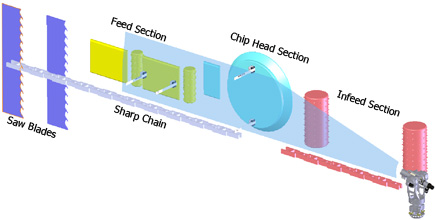
As previously discussed in our blog, we have found that sawmills of all sizes use piano wire, feeler gauges, mechanical levels, dial indicators and plumb bobs to perform critical machine alignments. It is not unusual to find outside service providers using some form of laser alignment device in a mill, but generally these systems are not owned by the mill. We have seen sawmills using outside alignment technicians as frequently as once a quarter, while still pulling wire between visits.
I believe that laser alignment has not been successful as an in-house solution for a couple of reasons. Lasers are generally expensive and require a number of special jigs and tooling to shoot all of the key measurements in a sawmill. And, although training is available, maintaining the knowledge required to use the laser systems over an extended period of time seems to have been problematic.
Why are most sawmills still pulling wire and outsourcing their machine alignments and line-ups? I think it is because many of the mills are simply not familiar with the advantages of using visual optical alignment. They have not been aware of an easy to use, highly accurate, affordable solution that they can bring in-house.
To be fair, visual optical alignment has arrived on the sawmill scene only recently. It utilizes an optical instrument called a jig transit. The jig transit is mounted on a stable platform, typically in the in-feed or out-feed section of the machine center. The transit's line of sight is then aligned with known reference targets. This produces an accurate and repeatable optical reference line used to align all machine components.
The jig transit is aligned to the centerline and sweeps an extremely precise vertical plane throughout the machine center. Key components like the chip heads, feed module anvils, spike rolls and band saws are precisely aligned for plumb, straightness and centerline using the jig transit. For components like rollers and machine ways, the transit can also sweep precise horizontal planes. This optical process is accurate to within .002" (.05mm) at 34' (10.4m).

Jig transits and the related accessories are a natural in the rugged sawmill environment. There are no wires to break or trip over, and no worries about wind, light, temperature, or humidity affecting results. No plumb bobs or levels, nothing to plug in. They are simple to use and set-up. We have found that millwrights and filers in the mills are able to use a jig transit with only a short learning curve. Our experience has shown that a jig transit can cut the time it takes to shoot a common primary-breakdown machine center by over 50%.
In our next blog, Part 3 of the series, we will discuss the Sawmill Kit that Brunson has introduced to the marketplace.

